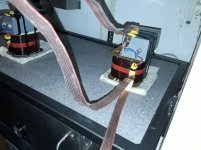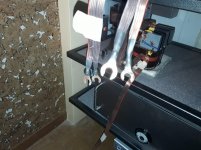the mundorf VN300 don't seem to be as "famous" as jantzen C-coil
here the mundorf: MCoil VN300 Zero-Ohm-Core | Mundorf EB GmbH
very poor description.
here the jantzen:
http://www.jantzen-audio.com/wp-content/uploads/2020/06/C-Coil-Data.pdf
http://www.jantzen-audio.com/wp-content/uploads/2020/05/C-Coil-Values.pdf
detailed description
the value i'm intrested is 4.7mH and i would to know the main techincal differences between them to choice which is better ?
the mundorf seems to be more bigger and more expensive but the transformer tech is better the toroidal or no ?
someone could help me ?
thank you very much
here the mundorf: MCoil VN300 Zero-Ohm-Core | Mundorf EB GmbH
very poor description.
here the jantzen:
http://www.jantzen-audio.com/wp-content/uploads/2020/06/C-Coil-Data.pdf
http://www.jantzen-audio.com/wp-content/uploads/2020/05/C-Coil-Values.pdf
detailed description
the value i'm intrested is 4.7mH and i would to know the main techincal differences between them to choice which is better ?
the mundorf seems to be more bigger and more expensive but the transformer tech is better the toroidal or no ?
someone could help me ?
thank you very much
Technical differences make zero difference at this level. The ear is the only arbiter. If lucky you may get some subjective opinions on the comparison, but how relevant would those be to your taste?
Hello,
In their pdf It says the Jantzen have a strong magnetical field. I have been using this mundorf for more than 2 decades in combination with a French paper in oil cap made in 1963 bought for 3 $ or less in a surplus store.
Greetings,Eduard
In their pdf It says the Jantzen have a strong magnetical field. I have been using this mundorf for more than 2 decades in combination with a French paper in oil cap made in 1963 bought for 3 $ or less in a surplus store.
Greetings,Eduard
Attachments
The C-Coil's magnetic field is contained in the core as it's toroidal. There is no stray field.
I have not heard the M-Coil, but I've used the C-Coils with no concerns.
Wolf
I have not heard the M-Coil, but I've used the C-Coils with no concerns.
Wolf
The toroid has a minimal leakage flux that escapes the core (travels through air) and that makes it slightly better EMI-wise. Since the leakage flux is also time-varying, it could potentially induce stray voltages in nearby conductors (e.g. a cheap cable running into an amplifier input) and cause problems. The toroid is therefore a highly recommended type of magnetic structure for high power applications.
Last edited:
This is a relative condition and shouldn't have an absolute kind of conclusion.The toroid is therefore a highly recommended type of magnetic structure for high power applications.
In any case at some level of power, toroids are especially susceptible to saturation, which causes a number of problems.
In any case at that higher power point, toroids are especially susceptible to saturation, which causes a number of problems.
The toroid is therefore a highly recommended type of magnetic structure for high power applications, provided its limits of operation are not violated.
This is a relative condition and shouldn't have an absolute kind of conclusion.
Sir, I think it's far from being conclusive because the toroid is just "a highly recommended" type among many others that are routinely used in the industry.
Any component is recommended provided its limits of operation are not violated...The toroid is therefore a highly recommended type of magnetic structure for high power applications, provided its limits of operation are not violated.
As to why the toroid is highly recommended was already mentioned in #5, and was therefore not repeated in #7. Thanks.
markbakk said:What's wrong with a decent I-core coil?

Flux leakage falls apart in a toroid at that point (a leakage field is created).newvirus2008 said:As to why the toroid is highly recommended was already mentioned in #5
Hello,
Paste and copy from English hifi-collective site"
The C-Coil is not recommended for any other use than on crossovers for passive loudspeakers, due the the toroidal cores strong output of electro magnetism.These coils are not suitable for installation in amplifers or active systems.
Greetings, eduard
Paste and copy from English hifi-collective site"
The C-Coil is not recommended for any other use than on crossovers for passive loudspeakers, due the the toroidal cores strong output of electro magnetism.These coils are not suitable for installation in amplifers or active systems.
Greetings, eduard
What's wrong with a decent I-core coil?
Well, nothing. I think they're at par with air-core coils. However, it's just the toroids that are special:
What-makes-toroidal-coils-different-from-normal-coils
Why is that and what point would "that" be ? And if there's a leakage field why would 'flux leakage' have to fall apart (or vice versa)? Don't you think it's supposed to prevail instead ? Could you please make it easier to follow?Flux leakage falls apart in a toroid at that point (a leakage field is created).
Last edited:
I have got the impression that laminated steel core inductors are very very good, and more expensive coils is just for showing off
Can some tell why the rod needs to extend a certain length beyond the windings
Can some tell why the rod needs to extend a certain length beyond the windings
All 'cored' coils tend to add some upper bass emphasis. That 'slam region' at about 70Hz or so. Air-cores do not do this.
Wolf
Wolf
I have got the impression that laminated steel core inductors are very very good, and more expensive coils is just for showing off
However, it is also important to note that electrical steel is meant for use at mains frequency and therefore it's complex permeability (mu vs freq) is poor at HF. The typical curve looks somewhat like in this link. Thus, they're good only as long as you use them for woofers crossed below 1kHz or so. For HF inductors that are usually lower values, use air-core or ferrite (but never use steel). And all this is true, only if they don't saturate (courtesy AllenB as always).
I would refrain from commenting on the 'bass slam' of steel as it is a highly subjective matter that varies from person to person.
Last edited:
Just use what you need where you need it, i don't think this is a problem.However, it is also important to note that electrical steel is meant for use at mains frequency and therefore it's complex permeability (mu vs freq) is poor at HF. The typical curve looks somewhat like in this link. Thus, they're good only as long as you use them for woofers crossed below 1kHz or so. For HF inductors that are usually lower values, use air-core or ferrite (but never use steel). And all this is true, only if they don't saturate (courtesy AllenB as always).
Some components, "worse" then others that are "ideally perfect", are better then, in certain applications.
In many cases with low woofer cutoff (low 3ways cutoff freq. or 4 ways) the steel core inductanze (c-coil) are better.
Also,for me, in this application, the jantzen c-coils are better than the zero ohm mundorfs.
I compared c-coil vs wax coil and c-coil in four ways at 200Hz is very very better than wax, but the wax are better for midbass, mis and high.
Just use what you need where you need it, i don't think this is a problem...
Call me obtuse if you will, but if that is your considered opinion on the subject, what is the point of this thread you started only 48 hours ago, asking whether a Mundorf transformer core inductor is 'better' than a Jantzen toroid core inductor?

Last edited:
Some components, "worse" then others that are "ideally perfect", are better then, in certain applications.
Yes, designs are according to the application, cost, performance, size, availability etc. and there is no winner (picture).
View attachment 937856
One more property is retentivity (having remanent flux) which is low for gapped cores, higher for non-gapped and absent in air-core coils.
Last edited:
- Home
- Loudspeakers
- Multi-Way
- Mundorf MCoil VN300 Zero -Ohm or Jantzen C-Coil ?

